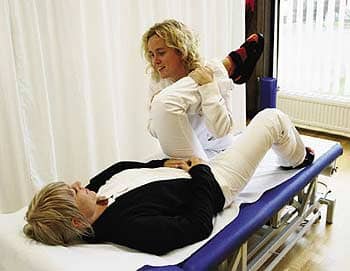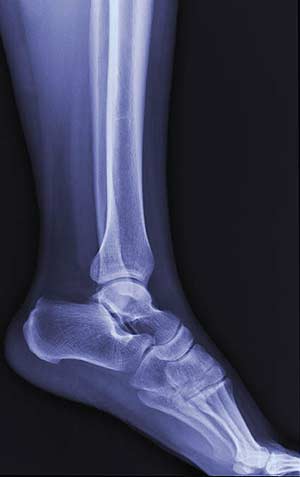Use these rules and the latest evidence to guide treatment where modern physical therapy has left textbooks behind

It is essential for clinicians to understand the different types of clinical prediction rules, and how they are developed, to safely and effectively apply them to clinical practice.
Too many decisions, too little time. How do you make a clinical decision? Do you fall back on your textbook knowledge learned in physical therapy school 20 years ago? Do you base it purely on what you have experienced in your clinical practice for the past 10 years? Or do you incorporate recent evidence of effectiveness or efficiency when making a decision? Hopefully, you answered with the latter!
Clinical decision-making has changed considerably in the past 25 years in the field of physical therapy. Our changing role in providing clinical evaluations of our patients and creating intervention plans for them has been driven by the evolving world of health care and the fact that consumers of our services continue to be more educated about their conditions and the management of them. It is our professional duty to ensure that we are at the top of our game with regard to the services we provide. One tool we have in our tool box to assist us with making the most sound and supported clinical judgments is clinical prediction rules (CPRs).
BACKGROUND OF CLINICAL PREDICTION RULES
Publication of CPRs in the physical therapy literature has grown in recent years with many clinicians anxious to apply these rules in clinical practice. It is essential for clinicians to understand how these rules are developed in order to safely and effectively apply them to clinical practice. The following is a brief summary of the process. The reader is encouraged to read the cited resources for a more detailed description of the development process.

Impact analysis, the final step in the development process of CPRs, is the clinical bottom line that asks, “What does this CPR mean to me and to the patients I serve?”
McGinn et al1 report that CPRs go through a three-step development process: derivation, validation, and impact analysis. Derivation occurs when a researcher identifies that a heterogeneous patient population exists, stakes for patient safety are high, and/or there is an opportunity for health care cost reduction. The researcher will create a list of variables or predictors that would identify the presence or absence of a condition, or a set of variables that would identify whether a patient would favorably respond to a selected treatment intervention. The variables to be studied come from the subjective and/or objective examination of the patient. The number of variables or factors must be kept in mind, as the study size must be large enough to prove the relationship between the symptom cluster and the clinical outcome, but not so large that clinician implementation is unlikely. A strong analysis will provide at least 10 subjects per variable being evaluated. Subjects are examined for the presence of the study variables and then compared to a reference criterion or gold standard used to identify the outcome of the rule. Once the reference criterion has been established, data analysis can occur to narrow down the list of predictor variables to the lowest number possible to accurately identify the outcome. Logistic regression is the most common statistical process used.2 Likelihood ratios are commonly used to report the effectiveness of the rule to identify the existence of a condition or likelihood of a certain outcome. The reader is referred to other statistical texts to review the definition and clinical importance of sensitivity, specificity, and likelihood ratios.

The Ottawa Ankle Rules are an example of a Level I CPR, found to decrease emergency department wait time, decrease radiological use with low false negative rates, and decrease patient management costs.
The next step is the validation of the rule. The purpose of this step is to confirm that the variables selected are not the result of chance or the design of the study, and that the variables are not exclusive to the patients in the derivation study.3 This requires that the rule be tested in populations outside the original study population to allow for generalization of the rule. Multiple validation studies should be performed on each proposed clinical prediction rule. In order for the validation to be successful in comparing the rule consistently, it is vital that researchers involved be properly trained in the use of any measurement item/tool or intervention procedure. Validation studies will mirror the derivation study regarding subject inclusion and exclusion criteria, but may differ in the setting in which the study is performed and/or may include a new pool of clinicians.
Impact analysis is the final step in the development process. It is the clinical bottom line and asks, “What does this CPR mean to me and to the patients I serve?” The most valuable CPR has evidentiary support that it can improve patient outcomes and decrease the overall cost of care. The most common form of impact analysis is a randomized controlled trial in which individual sites are selected to exclusively apply the rule to all patients or to not apply the rule to all patients.2 Few CPRs published in the physical therapy literature to date have impact analyses performed on them.
LEVELS OF RULES
All clinical prediction rules are not created equal. Therefore, application of a particular rule to a clinical situation should be taken with care. Clinical prediction rules are graded with levels from I to IV. Level I CPRs hold the highest clinical use value because they have undergone extensive validation studies in multiple patient populations and multiple practice settings, and were studies done by diverse groups of practitioners. Level I CPRs also have had impact analyses performed on them to determine their value in care provision with regard to efficiency of care, best patient outcome, and cost-effectiveness. CPRs designated Level I can be applied in the practice setting with confidence when making clinical decisions. Ottawa Foot and Ankle Rules,4 Ottawa Knee Rule,5 and Wells’ Rule6 are examples of CPRs that have had impact analyses performed and have achieved Level I status. Level II CPRs also can be confidently applied to clinical practice as they, too, have undergone broad validation studies. Level II CPRs, however, do not hold the strength that a Level I rule does in regard to the cost of care category due to the lack of an impact analysis. Level III CPRs have been validated only in populations similar to the original derivation study and should not be generalized to all patient groups. A Level IV CPR has undergone derivation analysis only without additional validation across practice settings and among varied patient populations. Level IV CPRs should be applied only in settings and with patient populations consistent with the derivation population.

Prediction of recovery in patients with low back pain is one example of a prognostic CPR.
TYPES OF PREDICTION RULES
Three types of clinical prediction rules exist in the physical therapy literature: diagnostic, prognostic, and interventional or prescriptive.
DIAGNOSTIC
Diagnostic CPRs allow clinicians to apply certain findings from the patient history, examination, and any diagnostic tests performed to identify a certain condition. Applying high level diagnostic prediction rules can decrease the duration of the episode of care, decrease cost of care, and prevent patient exposure to other unnecessary diagnostic procedures. Take, for example, the Ottawa Ankle Rules.4 This rule states that ankle radiographs are indicated when there is tenderness to palpation near the malleoli, and either the patient is unable to bear weight immediately and unable to take four steps in the emergency department or there is tenderness along the distal 6 cm of either malleolus. This is a level I CPR, meaning that it has undergone validation and impact analysis and was found to decrease emergency department wait time, decrease radiological use with low false negative rates, and decrease the cost of managing this patient population.7 The analysis shows a cost of care savings range of between $614,226 and $3,145,910 per 100 patients.

PROGNOSTIC
Prognostic CPRs provide useful information about the likely outcome for a patient with a specified set of findings. The availability of high level prognostic CPRs is limited. Most rules published in the physical therapy literature to date are level III and level IV rules, which should be applied with caution and only to very narrow patient populations that match the derivation study group. One example of a prognostic CPR is the prediction of recovery in patients with low back pain.8 This is a level III rule, which means it has undergone a validation study in a population that mirrored the original derivation population, so application of this rule to diverse populations is not appropriate. This rule states that if a patient has a numeric pain rating of less than or equal to 7/10, the duration of the episode is less than or equal to 5 days, and if the number of previous occurrences of low back pain is less than or equal to one, the patient has a high probability (95%) of a successful outcome when receiving manipulative spinal therapy, and non-steroidal anti-inflammatory (NSAIDs) medications.
INTERVENTIONAL
Interventional CPRs assist clinicians with the ability to predict which patients are most likely to have a positive outcome when a particular intervention or group of interventions is applied. Most of the prediction rules in the physical therapy literature are geared toward this category. We want to know what is effective in achieving a proposed outcome and what treatments will provide the best clinical outcome in the most efficient way. Flynn et al9 have created an interventional CPR on utilizing lumbar spinal manipulation for the treatment of low back pain. This CPR is a level II with validation; therefore, it can be applied in the clinical setting among populations similar to the original study design. This CPR is able to predict that in patients with the presence of four or more of the predictor variables (no pain distal to knee, <16 days onset, hypomobility in the lumbar spine, >35 degrees if hip internal rotation on either side, Fear Avoidance Belief Questionnaire Work subscale score of <19) who were treated with lumbar manipulation and exercise had a minimum of 50% improvement within 4 to 8 days. Improvement for this CPR was defined as at least a 50% improvement in the modified Oswestry Disability Index Score.

Communicating the utilization of clinical prediction rules during assessment and treatment planning can assist patient motivation and may increase their level of confidence in your care.
SUMMARY
Clinical prediction rules are becoming more common in clinical practice language. They assist in justifying a treatment plan based on current best evidence. Caution should be taken when applying the rules across the board to all patients unless rigorous validation studies have been completed. The bottom line is this: know the prediction rule that you want to apply and critically appraise it. Know how it was derived, who the study population was, and how the study was performed. Ask yourself, “What is the impact of this prediction rule on my practice and on the outcomes of my patients?” If those questions cannot be answered, generalized application of the rule is not in the best interest of the practitioner or patients. Use the rule with caution based on what current best evidence is available utilizing previous clinical experience and patients’ values regarding the current episode of care. Development of CPRs specific to physical therapy practice is a big step forward, and more work is needed. As stated by Fritz,10 “one attestation to the maturation of CPR-related research will come when we witness an increase in studies that aim to replicate, validate and examine the clinical impact of previously developed CPRs.”
Carrie Abraham, PT, DPT, MPH, OCS, is a Clinical Assistant Professor of Physical Therapy at Wheeling Jesuit University in Wheeling, WVa. She can be reached at .
REFERENCES
- McGinn TG, Guyatt GH, Wyer PC, Naylor CD, Stiell IG, Richardson WS. Users’ guides to the medical literature, XXII: how to use articles about clinical decision rules. Evidence-Based Medicine Working Group. JAMA. 2000;284:79-84.
- Childs JD, Cleland JA. Development and application of clinical predication rules to improve decision making in physical therapy practice. Phys Ther. 2006;86:122-131.
- Glynn PE, Weisbach PC. Clinical Prediction Rules: A Physical Therapy Reference Manual. Sudbury, Mass: Jones and Bartlett Publishing; 2011.
- Stiell IG, Greenberg GH, McKnight RD, Nair RC, McDowell I, Worthington JR. A study to develop clinical decision rules for the use of radiography in acute ankle injuries. Ann Emerg Med. 1992;21:384-390.
- Stiell IG, Greenburg, GH, Wells GA, et al. Derivation of a decision rule for the use of radiography in acute knee injuries. Ann Emerg Med. 1995;26:405-413.
- Wells PS, Hirsch J, Anderson DR, et al. A simple clinical model for the diagnosis of deep vein thrombosis combined with impedance plethysmography: potential for an improvement in the diagnostic process. J Intern Med. 1998;243:15-23.
- Anis AH, Stiell IG, Stewart DG, Laupacis A. Cost-effectiveness analysis of the Ottawa Ankle Rules. Ann Emerg Med. 1995;26:422-428.
- Hancock MJ, Maher CG, Latimer J, Herbert RD, McAuley JH. Can rate of recovery be predicted in patients with acute low back pain? Development of a clinical prediction rule. Eur J Pain. 2009;13:51-55.
- Flynn T, Fritz J, Whitman J, et al. A clinical prediction rule for classifying patients with low back pain who demonstrate short-term improvement with spinal manipulation. Spine. 2002;27:2835-2843.
- Fritz JM. Clinical prediction rules in physical therapy: coming of age? J Orthop Sports Phys Ther. 2009;39:159-161.



